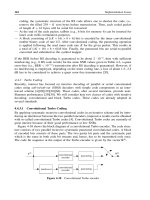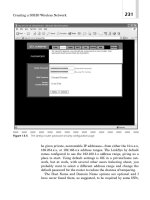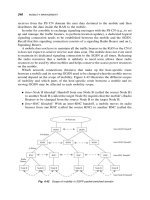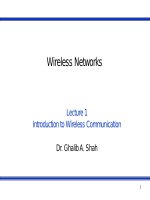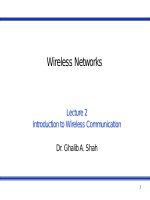Wireless networks - Lecture 7: CSMA and spread spectrum
Bạn đang xem bản rút gọn của tài liệu. Xem và tải ngay bản đầy đủ của tài liệu tại đây (447.89 KB, 22 trang )
Wireless Networks
Lecture 7
CSMA and Spread Spectrum
Dr. Ghalib A. Shah
1
Review of previous lecture #6
CSMA
► Versions of CSMA
► CSMA/CA
► Example
Spread Spectrum
► Frequency Hoping
► Direct Sequence
Summary of today’s lecture
2
Last Lecture Review
FDMA
TDMA
CDMA
Random Access
► ALOHA
► Slotted ALOHA
► Reservation-based ALOHA
3
Carrie r S e ns e Multiple Ac c e s s (CS MA)
Dis advantag e s o f ALOHA
► us e rs do no t lis te n to the c hanne l be fo re (and
while) trans mitting
► suitable for networks with long propagation delays
Carrie r S e ns e Multiple Ac c e s s
► po lite ve rs io n o f ALOHA
► Listen to the channel before transmitting
• if sensed channel busy, back-off (defer transmission), and
sense channel again after a random amount of time
• if channel idle, transmit entire frame
4
Versions of CSMA
Emplo ys diffe re nt no de be havio ur whe n
c hanne l fo und bus y
► no npe rs is te nt CS MA
• after sensing busy channel, node waits entire back-off
period before sensing again
► pe rs is te nt CS MA
• after sensing busy channel, node continues sensing until
the channel becomes free; then …
► 1pe rs is te nt CS MA
• node transmits immediately with probability 1
► ppe rs is te nt CS MA
• node transmits with probability p; or, it defers transmission
with probability (1-p)
5
CS MA / Co llis io n Avo idanc e
Us e d whe re CS MA/CD c anno t be us e d
► e.g. in wireless medium collision cannot be easily detected as
power of transmitting overwhelms receiving antenna
► CSMA/CA is designed to reduce collision probability at points
where collisions would most likely occur
•
when medium has become idle after a busy state, as several users
could have been waiting for medium to become available
► key elements of CSMA/CA:
•
•
•
IFS –interframe spacing –priority mechanism–the shorter the IFS
the higher the priority for transmission
CW inte rvals –contention window –intervals used for contention
and transmission of packet frames
Bac ko ff c o unte r–used only if two or more stations compete for
transmission
6
CSMA/CA Algorithm
Frame to
transmit
Medium
Idle?
No
Yes
Wait IFS
Wait IFS
Still
Idle?
Wait until
Trans ends
No
Yes
Transmit frame
Still
Idle?
No
Yes
Exp b/o while
Medium idle
If medium becomes busy during the backoff
time, the backoff timer is halted and
resumes when the medium becomes idle.
Transmit frame
7
Example
8
Spread Spectrum
Pro ble m o f Radio Trans mis s io n
► fre que nc y de pe nde nt fading c an wipe o ut
narro wband s ig nals fo r duratio n o f inte rfe re nc e
solution:
► spread narrow band signal into a broad band signal
using a special code
► initially developed for military in order to combat
jamming and inte rc e ptio n
► power of spread signal is the same as of narrow
band signal, resulting in a lower power spectral
density due to larger bandwidth
9
10
Spread Spectrum
11
Types of spreading:
► dire c t s e que nc e s pre ad s pe c trum (DS S S )
► fre que nc y ho pping s pre ad s pe c trum (FHS S )
12
Frequency Hoping Spread Spectrum (FHSS)
Signal is broadcast over seemingly random series of radio
frequencies
► A number of channels allocated for the FH signal
► Width of each channel corresponds to bandwidth of input signal
Signal hops from frequency to frequency at fixed intervals
► Transmitter operates in one channel at a time
► Bits are transmitted using some encoding scheme
► At each successive interval, a new carrier frequency is selected
Channel sequence dictated by spreading code
13
Frequency Hoping Spread Spectrum
Receiver, hopping between frequencies in synchronization
with transmitter, picks up message
Advantages
► Eavesdroppers hear only unintelligible blips
► Attempts to jam signal on one frequency succeed only at knocking
out a few bits
14
Frequency Hoping Spread Spectrum
15
FHSS Using MFSK
MFSK signal is translated to a new frequency every Tc
seconds by modulating the MFSK signal with the FHSS
carrier signal
For data rate of R:
► duration of a bit: T = 1/R seconds
► duration of signal element: Ts = LT seconds
Tc Ts slowfrequencyhop spread spectrum
Tc < Ts fastfrequencyhop spread spectrum
16
Slow-frequency Hop Spread Spectrum using
MFSK
PN Sequence 00
MFSK
0 1
11
1 1
0 0
01
1 1
1 1
10
0 1
1 0
00
0 0
ycneuqer F
Wd
Ws
Wd
Wd
Wd
T
M =4, k=2
Ts
Tc
17
0 0
1 1
Fast-frequency Hop Spread Spectrum using MFSK
PN Sequence
MFSK
00
0
11
01
1
1
10
00
1
0
10
00
11
0
1
1
ycneuqer F
Wd
Ws
Wd
Wd
Wd
T
M =4, k=2
Tc
Ts
18
10
1
00
1
FHSS Performance Considerations
Large number of frequencies used
Results in a system that is quite resistant to jamming
► Jammer must jam all frequencies
► With fixed power, this reduces the jamming power in any
one frequency band
19
Direct Sequence Spread Spectrum (DSSS)
Each bit in original signal is represented by multiple bits in
the transmitted signal
Spreading code spreads signal across a wider frequency band
► Spread is in direct proportion to number of bits used
One technique combines digital information stream with the
spreading code bit stream using exclusiveOR
20
Direct Sequence Spread Spectrum (DSSS)
21
Summary
CSMA
► Versions of CSMA
► CSMA/CA
► Example
Spread Spectrum
► Frequency Hoping
► Direct Sequence
Next Lecture
► Evolution of wireless networks
22

